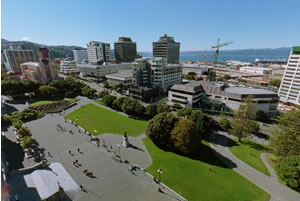Parliament Grounds
Parliament grounds from the Beehive. View as panorama.
New Zealand is one of the few places in the world where the public can walk around the grounds of Parliament. On a fine day, people sunbathe or enjoy their lunch on the grass; walkers getting from one part of Wellington to another use the grounds as a shortcut; and the rose gardens and sloping lawns make an ideal venue for special photographs, especially with the backdrop of the buildings. The grounds have been used as a place for groups of people to gather for celebration, to listen to important announcements, for protest, or to mourn the death of a major public figure.
The grounds around the first Parliament Buildings in Auckland in the 1850s and 1860s were bare paddocks. The grounds of the Wellington buildings were not much better, and it was not until the 1890s that they were landscaped and all the hollows and bumps smoothed into a gentle hillside. New gates were erected on Molesworth Street ― the main entrance – and from there, a carriage drive swept up to the front of the buildings.
It was in the 1890s that electric lighting was first installed in the grounds. Until then, MPs and others who worked in Parliament had to fumble their way out of the dark grounds aided by a gaslight that was lit only on evenings when there was no moon and even then was put out at midnight. There were stories of parliamentarians feeling their way along fences with the aid of umbrellas or sticks, and walking into posts and poles in the dark. Complaints finally led to the appointment of a gaslighter stationed on the corner of the grounds who doused the outside lights at 2 a.m. after the last member left.
The 1907 fire made redesign of the grounds necessary, and the basic format created in the 1920s remains largely unchanged today. Lawns and drives were set out, and deciduous trees and pohutakawa planted. The main entrance to the complex was put on the corner of Bowen Street and Lambton Quay where a large elm tree stood sentinel.
Hear Francis Fisher, MP between 1905 and 1914, reminisce about the nineteenth-century grounds (340k, mp3). Transcript and further information.
Piccolo Charley
A few people made Parliament grounds 'their place' ― somewhere to go to perform or to preach. One famous performer was Piccolo Charley, so named because of the tunes he would play on his musical instrument in the 1890s and early 1900s. With his small dog by his side, Charley would stand at the bottom of Molesworth Street and play the favourite tunes of politicians as they went by: 'Hard Times Come Again No More' for Joseph Ward, 'The Wearing of the Green' for Richard Seddon, a Maori lament for James Carroll. Charley was eventually moved along to the other end of town after someone complained about his music.
Statues
Parliament grounds include two statues of former Premiers. The bronze statue of Richard Seddon, Premier between 1893 and 1906, stands outside Parliament House. It was designed by British sculptor Sir Thomas Brock, and erected in 1915. Today it is one of the most photographed parts of Parliament grounds. Outside the Parliamentary Library is the statue of nineteenth-century Premier John Ballance. This marble statue, unveiled in 1897, originally stood on Parliament's front lawn. It was moved after the First World War when the grounds were re-landscaped.
Commemoration
Parliament grounds have been the location for important commemorative events, ranging from state funerals to remembrance ceremonies to Anzac Day events.
Memorial service for Queen Victoria, 2 February 1901, with the buildings draped in black crepe.
Anzac Day ceremony at the temporary Cenotaph, outside Parliament House, 1927.
Funeral cortege of Michael Savage, Prime Minister 1935-40, leaves Parliament grounds in 1940.
Protest
Parliament has been the natural focus for major political events, and protests about government policies. The unemployed gathered there during the economic depression of the 1930s, anti-war protesters chanted outside Parliament in the 1960s, and in 1975 and 2004, Parliament was the end-point of hikoi ― marches ― by Maori (and supporters) who travelled the length of the North Island to make their views known.
During the 1930s Depression the unemployed gathered at Parliament to vent their feelings. Here Prime Minister George Forbes addresses the crowd, c. 1932.
Parliament was the natural focus for the protests of the late 1960s, such as this group of people protesting against the Vietnam War in 1969.
Here a large crowd opposed to the Security Intelligence Bill gathers in the grounds in 1977. The nearly completed Beehive looms in the background.
See 1965 film of Parliament grounds and a Vietnam War protest held there.
Celebration
The combination of sweeping lawns, graceful steps, and the buildings themselves have made Parliament Buildings the venue for important public ― and private ― celebrations.
The remodelled grounds hosted many grand public events. The Duke and Duchess of York on their Royal Tour in 1901 arrive at the main entrance of Parliament to be welcomed by Premier Richard Seddon.
External link
Learn more about the features in Parliament grounds on the Parliamentary Service website.









